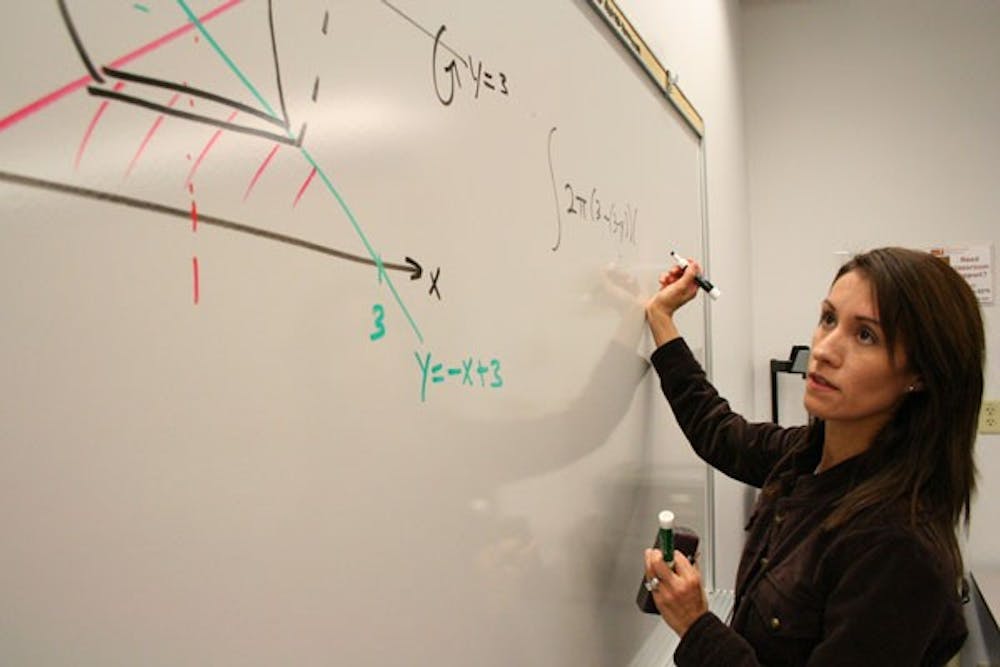Erika Camacho never planned on going to college or becoming a professor.
“College was not one of the possibilities that I saw in my future,” said Camacho, an assistant mathematics professor in the Division of Mathematical and Natural Sciences at the West campus.
Her perspective changed when she was encouraged to consider college and a career in mathematics by her high school algebra teacher, Jaime Escalante.
Camacho went to James A. Garfield High School in Los Angeles, where most students were from low-income families.
Escalante is known for his work to increase the number of high school students who passed the Advanced Placement Calculus test, which inspired the 1988 film “Stand and Deliver.”
“If he wouldn’t have inspired me, I probably wouldn’t have gone to college,” Camacho said.
The only career goal Camacho had in high school was to do well, graduate and get a “good job” as a store cashier.
If she worked as a cashier, she wouldn’t have to clean bathrooms or do similar jobs, she said.
“It was not that education was not valued,” Camacho said. “It’s just that when you’re poor, sometimes putting food on the table is more important than getting a degree or graduating from high school.”
Camacho was the first in her family to attend college and had some difficulty adjusting to college life and holding four jobs.
“I realized there was a gap in my education, so I was spending more hours than my peers studying,” she said.
Camacho managed to keep in contact with Escalante during some of her college years and said he helped get her through tough times.
Since Escalante was a math teacher, Camacho said his focus was to instill in students a love for mathematics.
“He would always make sure that we understood that with math, you could pretty much do anything,” Camacho said. “To be able to understand mathematics opens many doors.”
Math plays a role in many different fields, which Camacho said is apparent in her mathematical physiology research.
The work includes trying to understand the causes of certain degenerative eye diseases.
Camacho is also interested in mathematical sociology and is working to create models for social problems and phenomena.
Connie McNeely, a quantitative sociologist from George Mason University, is collaborating with Camacho on a project that would create a model and understand the impact the migration of science, technology, engineering and mathematics individuals could have on the U.S. and world.
“You see a lot of science, technology, engineering and mathematics high-skilled workers migrate from one place to another,” she said.
At first, Camacho wanted to be a high school teacher, then she became interested in engineering and eventually changed her focus.
She ended up double majoring in economics and mathematics at Wellesley College, but later earned her doctorate from Cornell University in applied mathematics.
She went to school at Cornell because of her experience during the summer at the Mathematical and Theoretical Biology Institute, which later moved in 2004 to ASU and is directed by Carlos Castillo-Chavez.
“[Castillo-Chavez’s] whole passion for helping students that were in need … really impacted me in a very strong way,” Camacho said.
Her experiences with inspirational mentors and teachers led her to become one herself.
Camacho helped start a similar summer program at Loyola Marymount University, called the Applied Mathematical Sciences Summer Institute, and still helps with the Mathematical Theoretical Biology Institute.
“One of the main goals of MTBI is to get students to graduate school — to get them interested in graduate school,” Camacho said.
Emmanuel Morales, an applied mathematics doctoral candidate, first met Camacho through the MTBI program and later worked on research with her.
Morales is working to develop a mathematical and statistical model to estimate the prevalence of drug injection users, a problem in his home country of Puerto Rico.
“She criticized me a lot and because of that, I think I end[ed] up with a good model,” Morales said.
Roger Berger, director of the Division of Mathematical and Natural Sciences, has known Camacho since she came to ASU in 2007.
“She’s very passionate about making mathematics accessible to people from very diverse backgrounds,” Berger said.
Reach the reporter at reweaver@asu.edu





